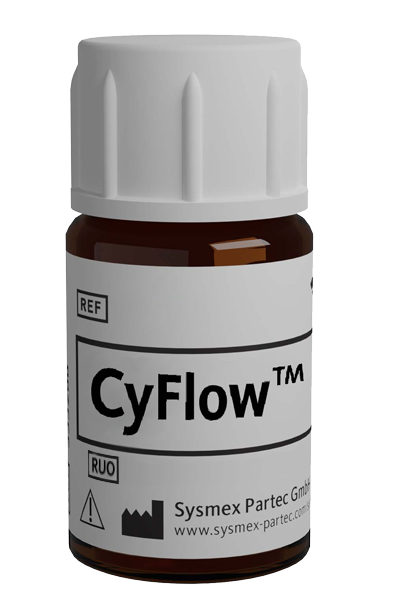CyFlow™ CD138 Pacific Orange™

| Alternative Name: | B-B4, Syndecan-1 |
| Antibody: | Yes |
| Antigen: | CD138 |
| Application: | Flow cytometry |
| Clonality: | monoclonal |
| Clone: | B-A38 |
| Emission Maximum: | 551 nm |
| Excitation Maximum: | 400 nm |
| Field of Interest: | Immunophenotyping |
| Format/Fluorochrome: | Pacific Orange™ |
| Isotype: | IgG1 |
| Laser: | Violet |
| Regulatory Status: | RUO |
| Source Species: | Mouse |
| Target Species: | Human |
| Product number: | CZ134087 |
For Research Use Only
| Quantity | 100 tests |
| Volume | 0.4 mL |
| Immunogen | U266 human peripheral blood myeloma cell line |
| Background Information | CD138 (syndecan 1) is a transmembrane proteoglycan that can bind a variety of cytokines and modulate their activity, as well as the activity of extracellular matrix components and influence many developmental processes. CD138 is expressed mainly in differentiating keratinocytes and is transiently upregulated in all layers of the epidermis upon tissue injury. It is also highly expressed on plasma cells and can be detected even on fibroblasts, vascular smooth muscle cells and endothelial cells. Up-regulation and down-regulation of CD138 on the cell surface often correlates with the gain of cancerous characteristics. Serum levels of the shedded soluble sCD138 are used as a prognostic factor of cancerogenesis. |
| Usage | The reagent is designed for Flow Cytometry analysis of human blood cells. Recommended usage is 4·µl reagent·/ 100·µl of whole blood or 10^6 cells in a suspension. The content of a vial (0.4 ml) is sufficient for 100 tests. |
| Storage Buffer | The reagent is provided in stabilizing phosphate buffered saline (PBS) solution, pH ≈7.4, containing 0.09% (w/v) sodium azide. |
| Storage | Avoid prolonged exposure to light. Store in the dark at 2-8°C. Do not freeze. |
| Stability | Do not use after expiration date stamped on vial label. |
| Hayashida K, Johnston DR, Goldberger O, Park PW: Syndecan‑1 expression in epithelial cells is induced by transforming growth factor beta through a PKA‑dependent pathway. J·Biol·Chem. 2006·Aug·25; 281(34):24365‑74. <·PMID:·16807246·> | Manakil JF, Seymour GJ, Bartold PM: Effect of cytokine and antigen stimulation on peripheral blood lymphocyte syndecan‑1 expression. Oral·Microbiol·Immunol. 2007·Aug; 22(4):272‑6. <·PMID:·17600540·> | Muto T, Miyoshi K, Munesue S, Nakada H, Okayama M, Matsuo T, Noma T: Differential expression of syndecan isoforms during mouse incisor amelogenesis. J·Med·Invest. 2007·Aug; 54(3‑4):331‑9. <·PMID:·17878683·> | Choi DS, Kim JH, Ryu HS, Kim HC, Han JH, Lee JS, Min CK: Syndecan‑1, a key regulator of cell viability in endometrial cancer. Int·J·Cancer. 2007·Aug·15; 121(4):741‑50. <·PMID:·17455248·> | Yang Y, MacLeod V, Dai Y, Khotskaya-Sample Y, Shriver Z, Venkataraman G, Sasisekharan R, Naggi A, Torri G, Casu B, Vlodavsky I, Suva LJ, Epstein J, Yaccoby S, Shaughnessy JD Jr, Barlogie B, Sanderson RD: The syndecan‑1 heparan sulfate proteoglycan is a viable target for myeloma therapy. Blood. 2007·Sep·15; 110(6):2041‑8. <·PMID:·17536013·> | Cheriyath V, Glaser KB, Waring JF, Baz R, Hussein MA, Borden EC: G1P3, an IFN‑induced survival factor, antagonizes TRAIL‑induced apoptosis in human myeloma cells. J·Clin·Invest. 2007·Oct; 117(10):3107‑17. <·PMID:·17823654·> | Kuchen S, Robbins R, Sims GP, Sheng C, Phillips TM, Lipsky PE, Ettinger R: Essential role of IL‑21 in B cell activation, expansion, and plasma cell generation during CD4+ T cell‑B cell collaboration. J·Immunol. 2007·Nov·1; 179(9):5886‑96. <·PMID:·17947662·> | Ojeh N, Hiilesvuo K, Wärri A, Salmivirta M, Henttinen T, Määttä A: Ectopic expression of syndecan‑1 in basal epidermis affects keratinocyte proliferation and wound re‑epithelialization. J·Invest·Dermatol. 2008·Jan; 128(1):26‑34. <·PMID:·17625591·> | Jilani I, Wei C, Bekele BN, Zhang ZJ, Keating M, Wierda W, Ferrajoli A, Estrov Z, Kantarjian H, O'Brien SM, Giles FJ, Albitar M: Soluble syndecan‑1 (sCD138 as a prognostic factor independent of mutation status in patients with chronic lymphocytic leukemia. Int·J·Lab·Hematol. 2009·Feb; 31(1):97‑105. <·PMID:·18190591·>
